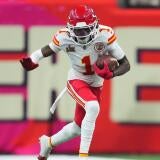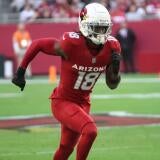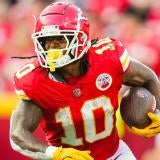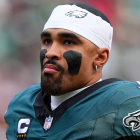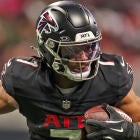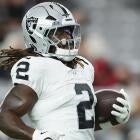Fantasy Football TE draft strategy: Brock Bowers, George Kittle, or Trey McBride as the top option?
The Inside the Lines team's proven NFL model has powered CBS Fantasy and SportsLine projections for over a decade, and they share their 2025 Fantasy rankings for all of the notable tight ends

Brock Bowers is the consensus No. 1 tight end based on our Week 1 to 17 projection, ADP and the Expert Consensus Ranking (ECR) from FFT. This was not always the case. A few weeks ago Trey McBride was FFT's No. 1, and he's still a clear-cut No. 2 based on ADP and FFT. But we don't see McBride's surprisingly low TD rate as something that we can just assume he'll fix.
We also see Travis Kelce refocusing this season enough to stave off the much younger Sam LaPorta. And when it comes to the two first-round rookies, we believe more in Tyler Warren getting all the targets he wants in a bad Colts passing offense than Colston Loveland, who will share targets in Chicago.
| TOP 32 TE | FP | ADP | ECR | |
| 1 | Brock Bowers | 15.3 | 1 | 1 |
| 2 | George Kittle | 14.8 | 3 | 3 |
| 3 | Trey McBride | 14.2 | 2 | 2 |
| 4 | Travis Kelce | 12.3 | 5 | 6 |
| 5 | Mark Andrews | 11.1 | 7 | 9 |
| 6 | Sam LaPorta | 11.0 | 4 | 4 |
| 7 | T.J. Hockenson | 10.9 | 6 | 7 |
| 8 | David Njoku | 10.9 | 8 | 5 |
| 9 | Zach Ertz | 10.3 | 13 | 15 |
| 10 | Darren Waller | 10.0 | 19 | 24 |
| 11 | Dallas Goedert | 9.9 | 15 | 16 |
| 12 | Jonnu Smith | 9.7 | 10 | 18 |
| 13 | Taysom Hill | 9.7 | 17 | 0 |
| 14 | Evan Engram | 9.5 | 9 | 12 |
| 15 | Jake Ferguson | 9.0 | 16 | 14 |
| 16 | Tucker Kraft | 9.0 | 11 | 8 |
| 17 | Hunter Henry | 8.7 | 23 | 21 |
| 18 | Tyler Warren | 8.5 | 12 | 10 |
| 19 | Cade Otton | 8.3 | 29 | |
| 20 | Mike Gesicki | 8.1 | 25 | |
| 21 | Brenton Strange | 8.0 | 21 | 19 |
| 22 | Pat Freiermuth | 8.0 | 24 | 30 |
| 23 | Dalton Kincaid | 7.9 | 18 | 13 |
| 24 | Isaiah Likely | 7.8 | 22 | 23 |
| 25 | Kyle Pitts | 7.8 | 20 | 17 |
| 26 | Dalton Schultz | 7.6 | 28 | |
| 27 | Tyler Higbee | 7.5 | NR | |
| 28 | Juwan Johnson | 7.3 | 26 | |
| 29 | Colston Loveland | 6.9 | 14 | 11 |
| 30 | Chigoziem Okonkwo | 6.8 | 27 | |
| 31 | Tyler Conklin | 6.8 | 31 | |
| 32 | Theo Johnson | 6.6 | NR |
Would You Rather Take Brock Bowers or Trey McBride as TE1?
Bowers is projected for more targets (143 to 131), more receptions (105 to 99), more yards (1,163 to 1,059) and more TDs (6 to 5). This should not be a controversial take considering Bowers had more targets, receptions, yards and TDs last season. Bowers accounted for 27% of team receptions, 29% of the team's receiving yards, and 26% of the team's receiving TDs as a rookie, and his role is not diminishing anytime soon. The other receivers that the Raiders added are young and unproven. The team will rush more with Ashton Jeanty, but he will also help the team extend drives. The additional plays, especially in the red zone, will benefit Bowers. The upgrade with Geno Smith at QB should make Bowers even more productive per target. Bowers caught 73% of his targets as a rookie and now has a much more accurate QB than the ones throwing him passes last season.
Trey McBride accounts for a similar amount of team receptions and receiving yards, but just 11% of receiving TDs. McBride's low TD rate is not an aberration. In fact, our projection of five touchdowns may be optimistic. He only has 6 TDs in 221 career receptions as a pro. He only had 1 in his last season at Colorado State despite having a whopping 90 receptions. That makes 4 years with a shockingly low TD rate.
Brock Bowers Best Futures Bet: Over 5.5 Receiving TDs +118 (FanDuel)
We are projecting six receiving TDs, so not a ton of line value, but when you can get +118 on that, we'll take it. While our model does project a significant 26% improvement in passing TDs, as a team with Geno Smith, that may be conservative considering they only had 19 last season. The Raiders averaged fewer than 80 rushing yards a game last season (dead last). With Ashton Jeanty, they could have a league-average running game, which could increase total scoring drives more than our model is projecting. Only Jakobi Meyers and Tre Tucker have accounted for more than 3.5% of the team's receiving TDs, so Bowers could be in line to increase his percentage of team receiving TDs from an already high 26% to 35%. You can bet on Bowers to have Over 5.5 receiving touchdowns at FanDuel, where new users can get $150 in bonus bets if their first bet wins:
Trey McBride Best Futures Bet: Under 4.5 Receiving TDs +102 (FanDuel)
We are projecting him for five, so that's technically an over lean, but when considering season futures, you will want to discount season projections by 15% as a rule of thumb to account for the high injury rate. Marvin Harrison Jr. did not have great chemistry out of the gate with Kyler Murray (just 16.6% of team receptions), but his awesome talent resulted in him getting a whopping 38% of the team's receiving TDs. What percentage will Harrison Jr. get when he is actually on the same page with Kyler in Year 2? Michael Wilson is also a high TD rate receiver who, despite accounting for just 13.5% of team receptions in his career, has accounted for 23% of the team's receiving TDs. Even WR3 Greg Dortch has a much higher percentage of team TDs (14.6%) than team receptions (11%). There are WR options that Kyler prefers to target for TDs over McBride, and that won't change this season.
Would You Rather Have Travis Kelce (Final Season?) or Sam LaPorta Year 3?
Even in a bad season, Kelce averaged more PPR FPs per game (12.2) than LaPorta last season (10.9). LaPorta was a high-volume target as a rookie (over 7 per game) but that dropped to just 5 per game in year 2. Experts generally rank LaPorta over Kelce because as he got healthy late in the season, LaPorta went back to being a 7+ target TE. But with Ben Johnson gone and John Morton in, we are not sure how TE-dependent the offense will be. Morton was the passing game coordinator in Denver last season and an assistant for the Raiders from '19-21, the Jets in '17 and Saints in '15-16, and these were not teams with notable fantasy production out of TEs.
The Chiefs are going to be more aggressive in their passing game after seeing the average pass attempts drop from nearly 40 per game in 2021 down to barely 35 in 2024. More passing and at least 10 yards per reception (8.5, a career low by 2 yards last season) keeps Kelce ahead of LaPorta even in what is likely his final season.
Travis Kelce Best Futures Bet: Over 675.5 Receiving Yards -110 (DraftKings)
With the return of Rashee Rice, a healthy Hollywood Brown to go along with Xavier Worthy, the Chiefs definitely could be more WR dependent and look to take more shots downfield. They will likely be successful in doing so. But this also results in longer drives, more plays, and wide-open TEs as defenses put 2 safeties high. Kelce and Noah Gray combined for 31% of the team's receiving yards with a 65/35 (Kelce/Gray) split. Even if we see declines of 31% to 28% and a split at TE of 60/40, we would still hit this Over. Our model projects KC to have MORE passing yards and Kelce to have more yards per reception to easily go Over this line. With all he's got going for him post-career, Kelce would not have come back if he didn't think he still could be an 85+ reception, 850+ yard player. You can bet on Kelce to go Over 675.5 receiving yards at DraftKings, where new users get over $200 off NFL Sunday Ticket and $200 in bonus bets instantly:
Sam LaPorta Best Futures Bet: Over 6.5 Receiving Touchdowns +100 (DraftKings)
While many fantasy owners who drafted LaPorta to be a PPR monster in 2024 were disappointed for most of the season, prop bettors kind of loved his mid-season TD production because his ATD lines would be based on his TD per catch rookie rate combined with his lower total receptions to start the season. He only had 12 receptions, under 150 yards and 0 TDs in his first 4 games. He only had 19 receptions in his next 7 games but had 5 TDs. While we do not project LaPorta to put up monster reception and yards (65 rec, 766 yards), we do project him to tie for the third-most receiving TDs by a TE with eight.
Would You Rather Have First-Round Big Ten Tight End Tyler Warren or First-Round Big Ten TE Colston Loveland?
Earlier this summer, Loveland was being drafted higher than Warren and was the consensus better fantasy option based on FFT's ECR and ADP despite Warren producing more last season (104 rec, 1233 rec yards, 218 rushing yards, 12 total TDs) than Loveland did the last 2 seasons (101 rec, 1231 rec yards, -10 rushing yards, 9 total TDs). But it appears that ADP/FFT ECR has come to their senses and moved to our side.
Loveland's college stats were limited by being on a loaded, run-first offense in Michigan's '23 championship team and then on a horrible QB situation in 2024. Warren played on a team that had a very good QB but no wide receivers. The reason why the model favors Warren well over Loveland is the fact that none of Warren's competitors for targets are highly ranked in fantasy. The FFT Consensus has Alec Pierce not even as a top 50 WR, and WRs Michael Pittman and Josh Downs are in the 40s. Warren's ability to line up anywhere and run the ball also helps produce FPs even if the passing game is 67% as productive as Chicago's.
Loveland isn't technically listed as TE1 on the depth chart (Cole Kmet was TE19 last season). WR2 Rome Odunze and WR3 Luther Burden are ranked comparably to the Colts' top WRs, and when you add in high-volume target DJ Moore, you just have twice as many mouths to feed. The Bears have never had a 4000-yard passer. Caleb Williams would have to have 5000 yards and 40 TDs to create a fantasy point pie large enough for Loveland's share to be significant as a rookie.
Tyler Warren Best Futures Bet: Over 500.5 Receiving Yards -110 (DraftKings)
The Colts' bad passing game still managed to have nearly 3400 yards last season, and we should see ~3500 this season. If Warren can have 15% of team yards, he hits the Over. Fifteen percent is not even half of the 34% of Penn State's total receiving yards he had last season. It's barely half of what Brock Bowers (drafted 13th) accounted for as a rookie (29%) in a similar situation where the team did not have a lot of other options to throw to and did not have good QBs throwing. Bowers had 1194 yards, and Warren may only be 70% of what Bowers is as a pure receiver, but that's still comfortably Over 500.5 yards. You can bet on Warren to go Over 500.5 receiving yards at DraftKings, where new users get over $200 off NFL Sunday Ticket and $200 in bonus bets instantly:
Colston Loveland Under 700.5 Receiving Yards -130 (bet365)
People are assuming Chicago's offense with Ben Johnson will look immediately like Detroit's, given they both have former #1 pick QBs and multiple talented WRs. And the assumption is like Sam Laporta, Loveland will be an immediate 60-yard-per-game TE. But remember, Detroit's offense benefited from playing in a dome, which is why they average 20 to 30 more passing yards at home and 15% more TDs per game from Goff at home. Chicago has never had a 4000-yard passer because of a lack of talent and the conditions at Soldier Field as early as October 1st. With 6 other skill position players who account for 10%+ of the team's receiving yards, Loveland will be lucky to get a seventh of the team yards (14%). For Loveland to reach 701, Caleb Williams would have to take a franchise that's never had a 4000-yard passer to one that has 5000 yards in a single season.

